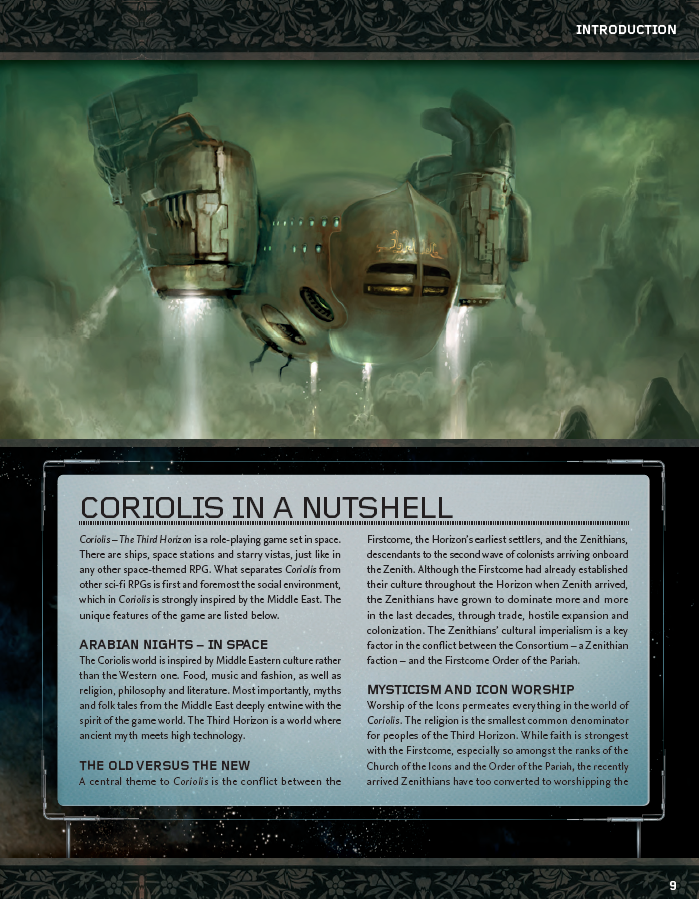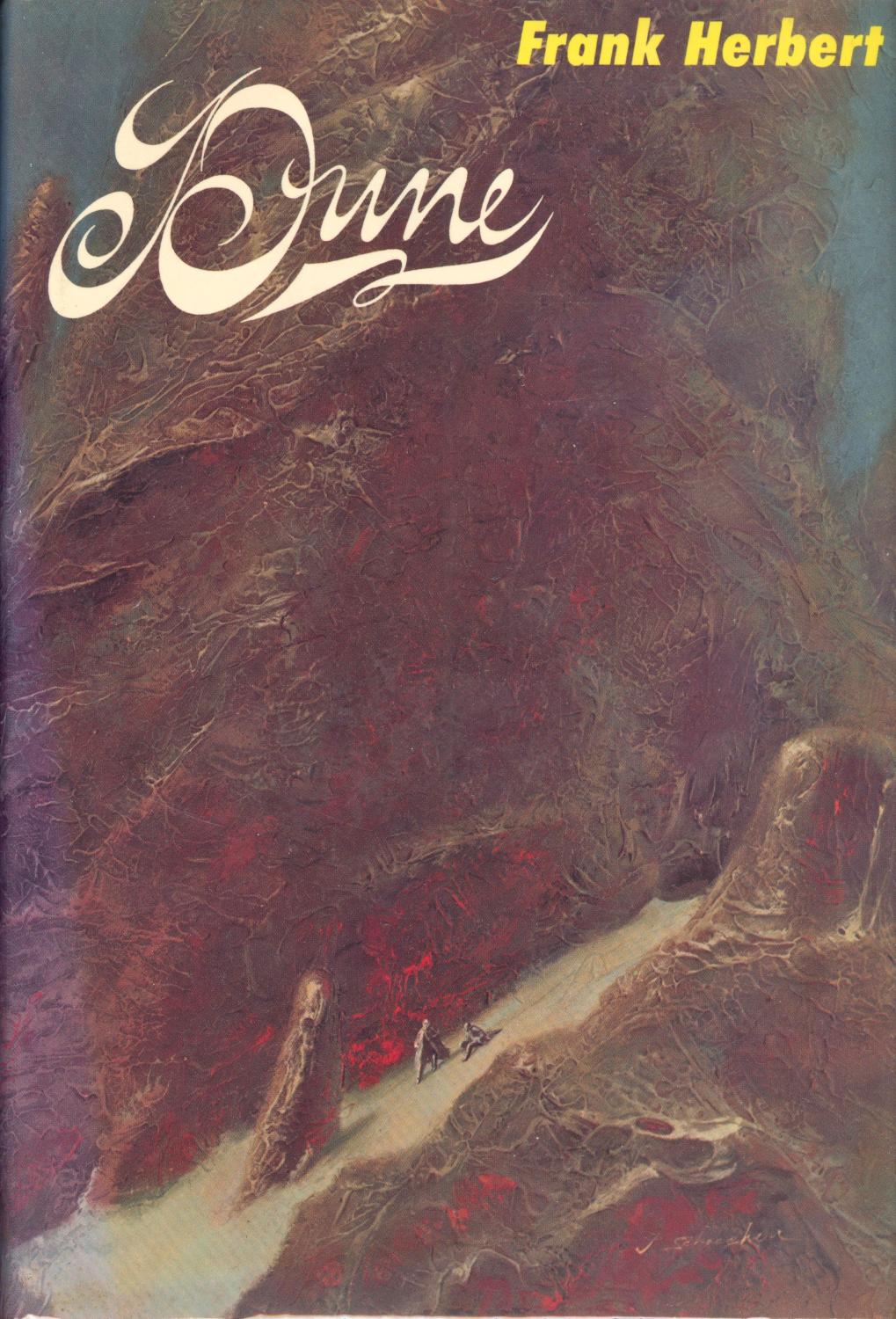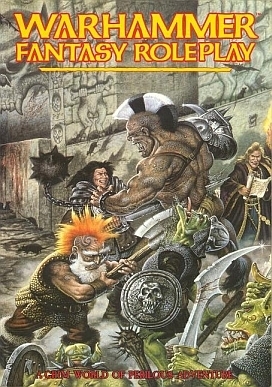 By Tomas Härenstam, Nils Karlén, Kosta Kostulas and Christian Granath
By Tomas Härenstam, Nils Karlén, Kosta Kostulas and Christian GranathReleased by Free League Publishing/Modiphius Entertainment
‘Coriolis – The Third Horizon is a science fiction role playing game set in a remote cluster of star systems called The Third Horizon. It is a place ravaged by conflicts and war, but also home to proud civilisations, both new and old. Here, the so called First Come colonists of old worship the Icons, while the newly arrived Zenithians pursue an aggressive imperialistic agenda through trade and military power.
In this game, you will crew a space ship and travel the Horizon. You will explore the ancient ruins of the Portal Builders, undertake missions for the powerful factions and partake in the game of political intrigue on Coriolis station – the centre of power in the Third Horizon. You might even encounter strange beings from the Dark Between the Stars.
From the Monolith in the jungles of Kua to the floating temples of Mira, the Horizon is yours to explore. You can be traders, explorers, mercenaries, pilgrims or agents. Whatever your calling is, together you will make your own fate. In the end you might even discover the truth about the mysterious Emissaries and the threat of the Dark Between the Stars.
Coriolis – The Third Horizon was awarded the ENnies Judges’ Spotlight 2017 and is produced by the makers of critically acclaimed Mutant: Year Zero (six-time nominee and winner of a Silver ENnie for Best Rules 2015).’

When Coriolis: The Third Horizon landed on my doormat I was already intrigued about the game. I’d read about it and enjoyed the excellent artwork, and the game felt like something I’d love to play. Mysterious, dark science fiction with mystical powers and supernatural, sometimes horrific occurences. That sounded like my kind of game.
I had no experience with Free League’s other games such as ‘Mutant: Year Zero’ or ‘Tales From the Loop’ and I knew little about the game’s system, so when I cracked open the 388-page book and started reading it I was expecting a comprehensive, detailed system so I was quite surprised by the light rules and the expansive setting.
The hardback tome is of excellent quality and the cover illustration by Martin Bergström, showing three about-to-get-into-trouble characters on a dark, forbidding world really starts the mood. In fact, the artwork throughout the book is of high quality with some shadowy, inspirational images and it’s supplied by Christian Granath, Martin Bergström, Gustaf Ekelund, Christian Granath, Magnus Fallgren, Tobias Tranell and Joakim Ericsson.
First we start with an introduction to the game; what we have here is a far-future setting in a cluster of stars far removed from Earth, and the entire setting is inspired by Middle Eastern culture, from the way religion is practised to the clothes they wear; this isn’t a straight-forward copy of any region or belief system, however, this has been designed and tailored specifically for the game. There is a short explanation about roleplaying games which gives a general overview but is pretty standard stuff. Is it new player friendly? Well, if you’re a regular GM and your players are new to it yes it is as the system is quite user-friendly and intuitive, but for a completely new group coming into the hobby cold maybe not so much.
Chapters two through to seven contain everything you need to create a character, use them in the game, crew a ship, equip them and travel the stars of The Third Horizon. The game’s premise is that the players are playing the crew of a starship and are travelling the Horizon to gather fame and fortune, with plenty of character templates to choose from to get you started - Artist, Data Spider, Fugitive, Negotiator, Operative, Pilot, Trailblazer, Preacher, Scientist, Ship Worker and Soldier – each with three of their own concepts to choose from to really help you individualise your character.

Each character has four attributes; Strength, Agility, Wits and Empathy. These are numbered between 1 and 5 – the higher the better – and also affect the skills each character has. There are General skills which everyone can do and Advanced skills that can only be performed if the character has training in them. You can also choose Talents, in-game abilities to help with rolls or situations.
There is a large focus on a character’s background; the game encourages talking about personal problems, their relationships with the other players, where the character comes from and their upbringing. Some of this has no real mechanical effect on the game and serves to give the character impetus, a reason for travelling the stars and a great starting point for roleplaying. There are hints and choices as to what kind of problems and backgrounds to consider but the game does encourage creativity and allows for players to create their own histories and issues. It’s a nice little addition that really pushes you to think a little deeper about the character.
This extra detail may be because the game system itself is really simple and easy to explain. When you want to perform an action you take a number of six-sided dice equal to the Skill score added to the Attribute score it’s associated with. Once you have a number of dice you roll them and any die that rolls a six equals a success. Just one six will succeed, but the more sixes you roll the better the level of success. The number of dice rolled is modified up or down by equipment, the situation and any other factors but as long as a six is rolled it’s a success, and if you get extra sixes then the success may have other benefits, such as a bonus effect that aids the group or a critical hit in combat.
So, for example, the Skill ‘Infiltration’ is an Agility-based Skill, so with an Infiltration score of 1 and an Agility score of 3, I get to roll 4 dice. If I roll any sixes it’s a success. The system is really easy to grasp, and the character sheet is simple and good to use. But what happens when things go awry and the players need help?
Well, then they can pray to the Icons, the religion of The Third Horizon. The Icons are a supernatural force that can help – or hinder – the players and if they fail a roll they can ‘Pray to the Icons’. This gets them a re-roll and increases their chances of success, or even add to existing successes, but beware; invoking the Icons results in a Darkness Point that goes to the GM, who can play this point at any time in the game to foul up the players; a NPC can re-roll, a clip empties, or a personal problem comes back to haunt the PC. So beware on calling for the powers for help – that can come back to haunt you. These Darkness Points can also be generated by using Mystic Powers; yes, players can also play characters with mental powers that can see through time, read minds and move objects… at a price.
I’m a big fan of the game system. It’s quick and easy to use, the rolls and their effects can be decided upon quickly and the combat is fun. There’s a critical chart for major damage which helps decide the severity of wounds and the chances of death, and I do think that this could have been stripped down to something a little less complicated to reflect the rest of the simple system. It can slow down the pace of an exciting encounter a little, but overall it’s still a great mechanic and it’s light enough to allow players to concentrate more on the actual character rather than the numbers on the page.
Continuing with character creation, the players then get to design a ship and then they decide who mans which role on the vessel; a Captain, an Engineer, a Pilot, a Sensor Operator and a Gunner. This helps to define their position on a vessel as the game revolves around their adventures on their own starship. There’s plenty of detail here, with rules for flying a starship across the Horizon to combat and everything in between but I can’t help but feel that, as with the combat critical chart, there’s a level of complication here that can slow down the game. Starship encounters revolve around a sequence of events that allows a Captain to issue orders and the players then have a pool of points allocated to them to enact those orders. There’s the Order Phase, the Engineer Phase, the Pilot Phase, the Sensor Phase and the Attack Phase. These phases give each player a chance to perform their designated ship duty – for example they can pilot out of trouble, divert power, and fire a weapon. As the players decide what to do the action can slow, and once again this felt out of place as the rest of the system flows so quickly. However, the nature of this aspect of the game calls for crew positions and the rules being split into phases really helps to highlight that as it gives a chance for everyone to be involved, with space combat being less about quick barrel-rolling dogfights and more about tactics and planning.

The second half of the book is chapters 8 through to 15, which detail the setting and it’s history, The Third Horizon, creatures and finally an adventure. This is the real meat of the book and it’s what gives the whole game it’s power.
The setting of Coriolis is one of mysticism, darkness, exploration, intrigue and adventure. This section will give you background about the setting, the Factions that live there and their political, sociological and spiritual leanings and influence, and a basic rundown as to what they’re like which can also help during character creation. There are ten major Factions and a selection of smaller groups that have great power in different areas, and then there are darker, more mysterious organisations that hide in the shadows. All of these Factions work with or against each other, openly or by subterfuge, and create all kinds of trouble across the Horizon. Throw in the Emissaries and reportedly dead Factions and you’ve got some serious political tension that can make for an amazing gaming backdrop.
However, there was a part of me that felt that there was more to the details presented, that we had been given a large chunk of data about the setting and the Factions but there was more below the surface, with some details being mere teasers. I imagine that this will be expanded upon in later supplements and adventures, but for now there’s plenty to be going on with.
The setting itself, as explained earlier, has a Middle Eastern influence. The dress, the names, the design, the whole aesthetic is of an Arabian style, and the artwork reflects this. The whole game, from the way people practice their beliefs to the writing on the hulls of starships, has an ethereal quality that really helps to enhance the atmosphere. Do you need to follow this theme? Not at all. The game allows for any ethnicity and you can easily change this aspect of it but I think this would take something away from the setting itself. The game literally oozes the Middle East vibe and that, I think, is one of it’s strengths.
This is then followed by a more detailed look at a star system, Kua, and the Coriolis, the space station that is there, and then an atlas of the Third Horizon as a whole. Beasts of both the normal and more exotic versions are then presented; there isn’t much here and more illustrations would have served it well, but there’s enough to be going on with. The book is then rounded out by an adventure and then a much-needed index.
So… how did I get on with it?
I’m not going to beat around the bush. I loved it.
At first I wasn’t sure how to sell this to my group. It was a little removed from the type of things we’d played before and the setting and system was new to me, but it was an easy sell in the end. I just told them that the game was a combination of the TV show ‘The Expanse’ and Frank Herbert’s ‘Dune’. You see, I’d just come out the other side of a Frank Herbert book session when Coriolis reached me and it couldn’t have hit at a better time. I was pumped up on the spiritual aspects of the classic novel and the ideas of religious fervour and misguided hero worship, and I’m also a huge fan of ‘The Expanse’ and the political turmoil it presents, not just on the solar system but on the little people, too. Once I sat down, gave that analogy, and then explained the setting of the game and the basics of the system we were ready to go.
Explaining the system to the players was easy. Add Attribute and Skill, roll, and I want to see sixes. None of them had any experience with the system and they took to it quickly, with hisses when no sixes showed and smiles when they did. I was on hand to explain extra effects and the only slowdown and page-turning occurred during combat, but that’s to be expected with any game. The first combat was a simple firefight, four players against four bad guys, and it was resolved in perhaps fifteen to twenty minutes.
However, the starship combat really slowed things down, and it was agreed (after a forty minute vessel encounter) that we’d leave the starship rules for a while until we were totally okay with the rules at large. When we did come back to the next starship combat we were ready for it and it worked out much better, but it was still long and felt out of place with the rest of the system. It wasn’t a bad thing; in fact, the players appreciated the chance to have ship positions where they were able to have a hand in the entire proceedings. Some game systems allow players to blast across the cosmos while the groundpounders have to pick their nails, but this game gets everyone involved.
The setting is where the game shined. The mystical science fiction Middle East really helped set the tone as not only was it science fiction, with all the tech and space travel trappings that comes with it, but it also had an exotic quality to it that gave it an edge of unreality. The players really got their teeth into it and had fun with it, and by the end of the session we had (badly reproduced) accents and web surfing looking for Arabian clothing and designs. It made for a great game, and the game designers should be applauded for their design choice.

I think I clicked with Coriolis straight away because of my ‘Dune’ stint and the frame of mind I was in at the time, but don’t let design choices put you off. If the setting isn’t your thing then change it; there is nothing in the setting that affects the game mechanically. Don’t like the choice of setting? Then change it to something else, maybe Far Eastern or African. If you don’t like the mysticism then drop that, too, and then you’ve got a perfectly useable science fiction roleplaying game that you can use in quite a few different settings, including settings such as ‘The Expanse’ and ‘Dune’. It makes for a pretty decent science fiction roleplaying game as it is, and the detailed setting is a huge bonus.
It was an excellent experience with the easy to use system, the wonderful setting and the way the player characters are encouraged to have a depth and an important role in the game. It really gets everyone involved from character creation, through starship design and crew designation, and through to the game itself. Players can have an influence on the fate of their characters and the story with the Icons, and suffer problems as a result, and this in itself creates a high level of drama that is only accentuated by the mysterious, powerful setting. It allows you to play games filled with adventure, mystery, spirituality, investigation, horror and exploration. It not only allows you to travel The Third Horizon, it allows you to experience it with a character you care about because they, too, have histories, dreams and goals. And for the GM it’s quick to set up a game as the system is easy to use and NPCs easy to create, so you can focus on the story and the plot and really create a saga for players to grab hold of and dive in to.
I have my issues – the slowing of gameplay during combat encounters, the compexity of starship creation and combat, and the somewhat incomplete feeling I got from the setting – but these are far outweighed by the positives of the game and I’m sure that these issues will smooth out over time and experience with the game and the inevitable expansions and supplements.
Coriolis: The Third Horizon is one of the best games I’ve come across in years, both in setting and mechanics design. It’s wonderfully presented and it’s a great read, and if there was such a thing as a ‘Farsight Blogger Seal of Approval’ then this game would be getting it.
Highly recommended.











